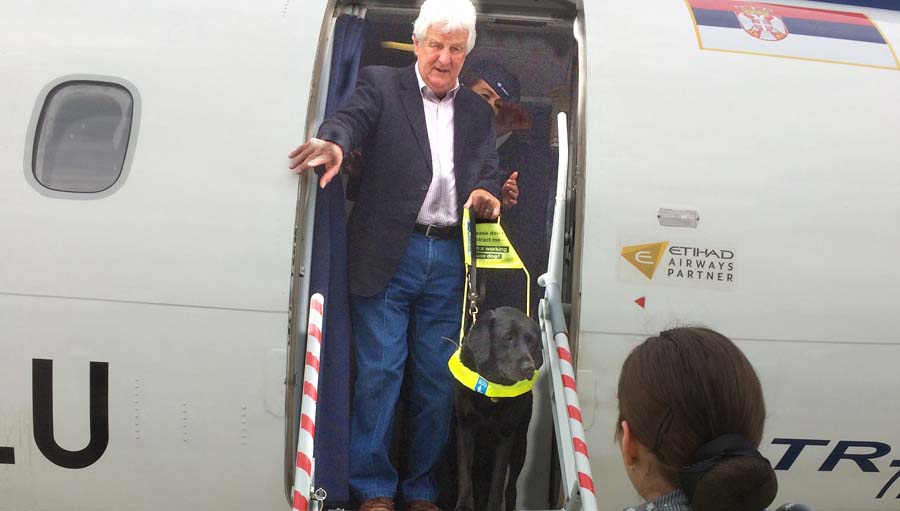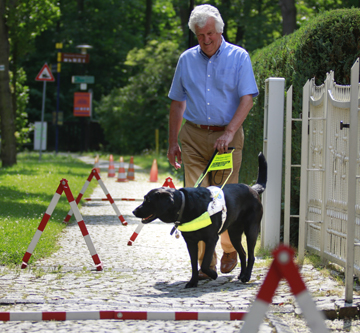Join a powerful, unprecedented alliance for better eye health for all.
Join IAPB-
Choose an alternate language here
 Celebrating International Guide Dog Day 2018.
Celebrating International Guide Dog Day 2018.
Losing one’s sight is certainly a life-changing event. But those fortunate enough to be paired with a guide dog usually say that is the greatest benefit they can have, short of regaining their sight. A guide dog gives them back their independence, enabling them to get out and about anywhere a sighted person can go. However, they can get discouraged – and even fearful of going out – if people such as taxi drivers, shopkeepers and restaurant owners discriminate against them by refusing their right to enter with their well-trained dog.
Guide dogs are expensive; in the UK it costs £55,000 for the training and upkeep of each dog. Demand far exceeds supply and Guide Dogs UK, the largest guide dog school in the world, can produce only 800 trained dogs per year for an increasing blind population.
The European Guide Dog Federation campaigns across Europe for guide dog users to have the same rights as other citizens and to ensure that these rights are enforced. We fight the double discrimination against the disabled person and the dog. We have nearly fifty member organisations in 27 countries – both guide dog training schools and guide dog user groups. We also support the European Coalition for Vision’s work in preventing avoidable blindness, alongside IAPB.
On access issues we work closely with Assistance Dogs Europe because the problems and challenges are similar, whatever disability the dog is trained to assist.
During the past 18 months we have become leaders in a project to set a European standard for all assistance dogs. A broad range of assistance dog professionals from across Europe have come together to define what is (and what is not) an assistance dog. We want to facilitate access for disabled people with a properly trained dog, while denying access to people with “fake” dogs, (a big problem in the USA but not yet in Europe). Essentially, we will be also considering dog welfare standards, staff skills and competencies, training and assessment methods, client services, and accessibility.
The project is carried out by a technical committee, TC452 Assistance Dogs, under the auspices of the European Committee for Standardization (CEN). Members are nominated by national standards bodies of member countries in Europe.

The European Consumer Voice in Standardization (ANEC), is an influential partner organisation in all CEN projects and they have delegated their representation on assistance dogs to David Adams (who also draws from his own experience as a guide dog owner of ‘Zoey’) and myself both from EGDF. As ANEC experts, we are consulted on all new and revised standards, where we represent the interests of all blind consumers, not only those with dogs.
The first guide dogs were trained in Germany 100 years ago to help veterans blinded in World War I. Currently there are about 20,000 guide dogs and about 7,000 other assistance dogs in Europe. “Guide dog” has been the most frequently-used term but the CEN committee agreed that “assistance dogs” includes guide dogs and other types of assistance dogs.
The International Guide Dog Federation (IGDF) and Assistance Dogs International (ADI) have been evolving standards for many years, which have been used by the European Civil Aviation Conference (ECAC) to allow properly trained assistance dogs in the cabin of the aircraft.
There are some criticisms such as IGDF and ADI are peer group organisations, setting the standards by which their own members are appraised, dogs trained by a trainer who has left the employee of a school or by the user do not have the same rights of access and that Austria has set up their own governmental system of assessing assistance dogs.
Recognising these anomalies IGDF and ADI are open to change and are participating on the committee. We intend that this standard will lead to a global standard. This is the first standard for living things — the dogs, their trainers, and their human partners, making it a new experience for all experts and delegates involved. One of EGDF’s objectives has been to get a broad range of experts involved from across Europe. 15 countries plus CEN, ANEC, IGDF and ADI are now participating in face-to-face meetings.
The first working group has produced draft terminology for comments by the national committees. We have proposed the following types of recognised assistance dogs: assistance, autism assistance, diabetes assistance, guide, hearing, mobility assistance, PTSD assistance, seizure assistance. The next meeting will be in Brussels in May.
On International Guide Dogs Day we ought celebrate these wonderful creatures. Going beyond we will continue to advocate so that far more people can avail of them, systems are better regulated and discrimination against users comes to an end.